Back in early 2016 ESP launched its first range of Cryogen hooks. These were the culmination of nearly five years in development and due to the new manufacturing processes employed, were a genuine improvement on any hooks we had produced before. The new manufacturing and tempering resulted in hooks that were over 20% stronger in tensile strength and hardness, without having to increase wire gauge. The result was a range of hooks which were incredibly strong and this strength and hardness allowed for super sharp points which were also very durable.
They looked just right - on paper at least!
The six hooks in the Cryogen range were predominantly refined and improved versions of previous ESP Raptor patterns, encompassing most of the popular mainstream types – a comprehensive all round selection which catered for popular rigs and methods and they have proved hugely successful.
The only missing pattern was a long shank. Our earlier Raptor Long Shanx were based on the traditional B-175 lure hook, much like similar patterns from other companies, with a long straight shank, in turned eye and straight point. They were never as popular as other Raptor patterns though, perhaps a little niche and as such this type of shape was not really on our radar when we designed the Cryogen range.
23rd April 2018 - a very rough sketch of what I had in mind
Over the last couple of years, as new methods and trends emerge within our sport, we began to get asked regularly for a Cryogen Long Shank. From a design and manufacturing point of view, It would have been very easy to go down the old faithful B-175 route, make a few tweaks here and there and produce a perfectly functional traditional lure hook style pattern using the new Cryogen processes. But that would have been somewhat short-sighted and we wanted to set the bar slightly higher with a more ambitious design…
The explosion in popularity of the Ronnie rig since the initial Cryogen’s were launched was a significant one and played a major factor in this decision. Could we create a new pattern that was even more effective for this set up than the widely adopted Curve’s but at the same time fulfil the requirements the original Longshanx delivered?
What we had in mind was an amalgam taking the best properties of a curve and making it physically longer but with a wider gape than the traditional lure hook styles. With the advancements the Cryogen process now affords in terms of point hardness we knew this could be optimised in length, creating an even finer, sharper point without any significant compromise in strength. A few rough doodles later and it looked like we had the basis for exactly what we wanted.
Working with our CAD engineer we soon had a range drawn up. Proportionally the same size as the old Raptor Long-Shanx, in corresponding wire gauges, but with a much more aggressive shape and longer, considerably sharper point. Initial impressions were very good, but we toyed with the sizing and proportions until they looked just right – a family of five sizes which ticked all the boxes (on paper at least!).
The next step was to get samples made based exactly on our technical drawings. Initially this was just the size 4, the largest in the family. A few months went by and then notification was received, the samples had been made and from the photos they looked very promising indeed. Not long after, just after Christmas 2018, a small box arrived.
From rough drawings to CAD where the whole family of sizes is proportioned and dimensioned correctly
First impressions were very good, proportionally they looked sound, the shape looked mega aggressive and on tying a few up bottom bait fashion they flipped and pricked instantly on palm tests, even without a kicker or shrink tube. The subtle sweeping curve to the long shank combined with a gently in-turned 9° eye, long point section and wide gape created a shape which naturally ‘triggered’ and ‘hammered’ the point home as the hooklink was tensioned. In terms of strength, they had just the right amount of ‘spring’, that inbuilt shock absorber that results from the combination of the correct high carbon steel, forging and tempering that means the finished hooks are neither brittle nor soft.
On Ronnie’s they just looked perfect from the off, with the subtle curve in the extended shank presenting the point in a more upright, yet still claw-like attitude. The only flaw was the point sharpness, they didn’t feel quite 100% and there was a little too much ‘meat’ above the point where the fast taper ran out too quickly and resulted in a point that was sharp, but fractionally ‘stubby’ so there was room for improvement on this most important aspect.
So we adjusted the point length to wire diameter ratio, which would fine it down and hopefully create the hypodermic sharpness that has become such a critical requirement to the discerning angler. A report with revised drawings was duly sent to the manufacturer and a second wave of samples - this time in multiple sizes – was underway.
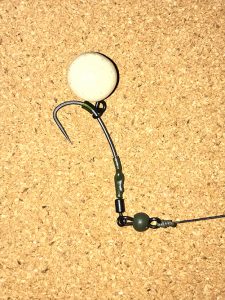

On a Ronnie, the Trig-Hammer sits with aggressively poised attitude. The resultant hooks holds are exceptional.
The obligatory couple of months past, notification’s received, photos looked promising and then the moment of truth arrived. Were the points sharp enough? The first box I checked was the size 4, to compare them with the first samples. I reached into the bulk bag of 1,000 to take a random few out – ouch! They certainly felt sharper and I proceeded with more care. I picked one up, the standard finger skin tests instantly drew a pin prick of blood and then fingernail tests proved sticky sharp. The point profile was long, fine and clinically needle like and looked exceptionally good – far superior to the first samples. The slick PTFE surface finish was also in just the right shade of dark grey, and undoubtedly helps improve penetration. As an aside, a lot of people reading this might not know that ESP was the first mainstream company to launch PTFE (Teflon) coated carp hooks onto the market, with the Raptor Big-T’s, way back in 2001, thereby setting an industry standard.
Checking more samples under a high powered microscope confirmed the consistency and all the sizes provided the same degree of refined sharpness. Physical proportions across the whole range looked spot on and I was excited to send them out to a number of friends and anglers who I knew would appreciate them but also provide honest and constructive feedback.
Of the anglers I initially sent the full range of sizes to, one was a mate, Ross Bancroft. Now Ross has for a long time been a committed hook sharpener. His collection of files would grace any engineer’s workshop and as such he is ultra-critical when it comes to hook sharpness. He had just started looking at a large unfished reserve which pretty much unknown potential. He knew of an upper 30 mirror which had been caught last year but precise details were fairly scant.
The day after I sent the hooks to Ross he made his first trip to the reserve. He had received the hooks that morning and already enthused about their sharpness, raving about how he wouldn’t need to get the files out of the tackle box. A quick afternoon session following work on a pre-baited spot and the message came out of the blue – after an epic scrap Ross had caught a long scaly 27lb mirror, a complete unknown, possibly never been caught before and he reported how it was securely nailed on one of the new size 5’s – a very promising start indeed.
Ross returned the following day, again just for a few hours after work and amazingly within a very short space of time he had a whacking great mirror in the net – all 41lb of it! After that they kept coming, and baiting and fishing the reserve based on optimum conditions, he has now accounted for eight different carp (at the time of writing), including a different 41lb mirror, with the average weight being well over 30lb. All of them caught on Ronnie’s with the size 5 Trig-Hammers and Ross has reported that the hook holds have been consistently impressive.
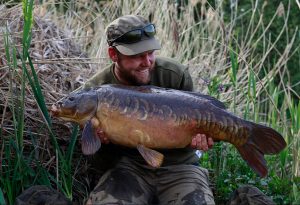
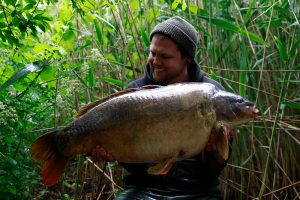
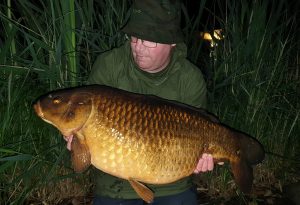
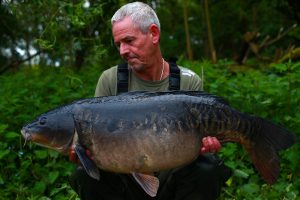
First time out on the Trig-Hammers for Ross and an uncaught 27lb fighting machine and likely uncaught 41lb mirror. Dave Ellyatt with a chunk common on a guesting session. Spence Butler with a Belgian canal unit.
The above is just one example but other lads I sent them to were similarly impressed and caught on them from the off – Spencer Butler, Alfie Russell, Phil Buckley, Alex Grice, Tim Harris, Rogier Smit and Tom White, all good anglers with a critical eye. Tel loved the points and although he is not really a long shank buff, his attention to detail on point sharpness is second to none.
The Trig-Hammer is probably the Cryogen pattern I have been most happy with and I’ve caught a few on them as well, on Ronnie’s with the 5’s and slip D bottom bait rigs with the 6’s for boilies and 7’s for tigers. The range also includes the aforementioned size 4 and a size 8. We have created a hook which makes the Ronnie rig even more effective and the way they flip and penetrate and the resultant hook holds on bottom bait rigs means these are a true all-rounder.
Probably previously uncaught... a 41lb unit and another victim to the size 5's for Ross
The following night I was back in the zone, ready to go, but this time I had set up much closer to my rods. I had landed everything I had hooked so far but I knew that linear was going to be a different breed all together. After two more nights and two more commons I finally got the bite I had been waiting for, and I knew what I had hooked as soon as I picked the rod up. The spool was emptying faster than I could get my waders on, this was it, my chance at the linear as it grated through the branches as I desperately tried to retrieve it. Il be honest, I thought I had blown it as it came to a holt under the overhangs. I stood in the water, full test curve for a few moments when suddenly something gave and I was back in contact with the fish. After a little bit of ‘to me to you’ under the tip she was mine, and what a carp it turned out to be. Longer than I could have ever imagined and scale perfect from top to tail, she was amazing and my time on the estate lake was over, for now. Two trips back to the van on dusk was what it took to get my gear out, but it was worth it.
Rejected points on the left, new points on the right
Archives
Categories
Recent Posts
- E-S-P April Product Launch 2024!
- E-S-P July Product Launch 2023!
- A Tricky Autumn Comes Good – Kev Hewitt
- Carp Team England Wins Gold!
- Barry Hearn Masterpiece!
- E-S-P July Product Launch 2022!
- Kev Hewitt – A Golden Ticket
- Kev and Bart cruise to the BCAC Semi Finals
- Fishing is the best medicine – Darren Blunt
- A Trip To The Country – Alfie Russell
- Paring it down – Dave Ellyatt
- Daren Norman – Burghfield Challenge
- Daren Norman – Long awaited Cassien trip!
- Decluttering: Back To Basics with Alfie Russell
- ESP’ New Ronnie Clips: Inception to Finished Product
- Kev Hewitt’s 50th UK 40lb Carp!
- When it all comes good – Alex Grice
- Liquid loading your bait – Tom White
- Watercraft: The whys and wherefores – Kev Hewitt
- The Development of a Carp Hook – Dave Ellyatt




